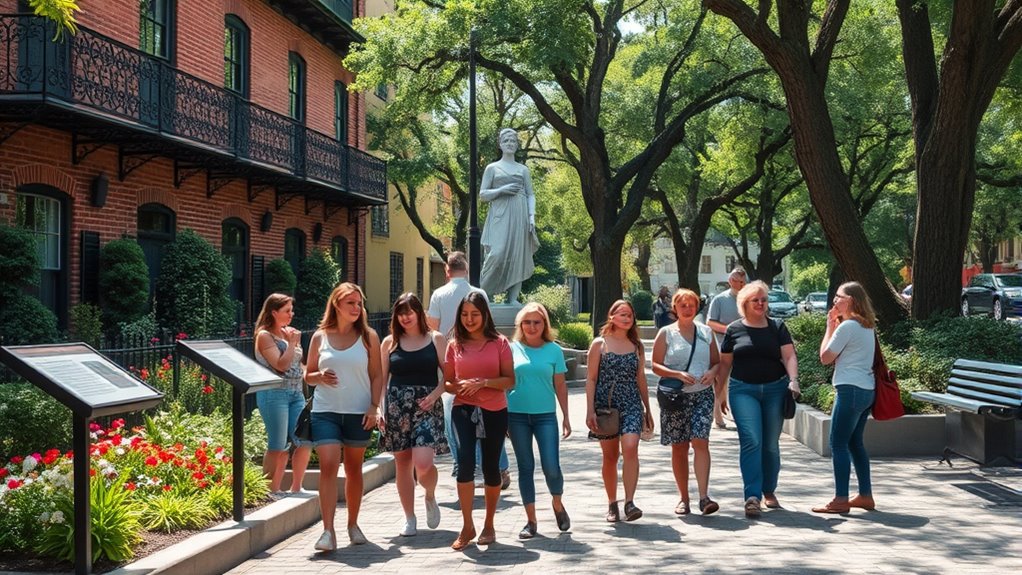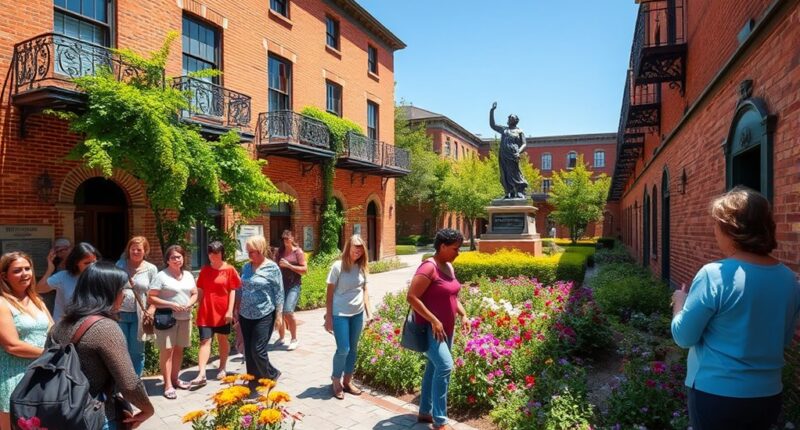HerStory Trails invites you to explore women’s museums and historic sites that highlight women’s stories, achievements, and struggles often overlooked by mainstream institutions. These sites aim to challenge gender-biased narratives and promote more inclusive cultural understanding worldwide. As you discover these places, you’ll see how they preserve women’s histories and inspire change. If you keep exploring, you’ll uncover even more inspiring efforts to recognize women’s essential contributions across cultures and time.
Key Takeaways
- HerStory Trails connects you to women’s museums and historic sites worldwide, highlighting women’s stories, achievements, and cultural contributions.
- Discover museums dedicated to women’s history, art, activism, and unique narratives often overlooked by mainstream institutions.
- Explore initiatives that promote gender equity and visibility of women in cultural and historical preservation.
- Learn about networks like the International Association of Women’s Museums supporting global collaboration and resource sharing.
- Find opportunities to engage with exhibitions, tours, and programs that celebrate women’s diverse experiences across different regions.

Women’s museums and historic sites have emerged as essential spaces that challenge the longstanding underrepresentation of women in mainstream cultural institutions. These dedicated venues address gaps in gender representation by highlighting women’s contributions to history, art, and culture that mainstream museums often overlook. Their origins trace back to the early 1980s during the height of feminist movements, when activists recognized the need for institutions that showcased women’s stories, achievements, and struggles. Initially, these museums focused on filling the void left by traditional museums, emphasizing women’s history, culture, and artistic expression that had been marginalized or ignored. Over time, they developed globally, forming networks like the International Association of Women’s Museums (IAWM), which helps coordinate efforts, share resources, and promote visibility for women’s contributions worldwide. Today, there are over 300 women’s museums worldwide, reflecting the growing recognition of women’s history and contributions. Despite these efforts, gender representation remains uneven, especially within the art world and museum leadership. Women artists continue to face significant underrepresentation; for instance, 87% of artists in major US museums and 93.4% in French museums are male. Female artists have historically been excluded or marginalized in permanent collections and major exhibitions, and recent studies show only about 11% of acquisitions from 2008 to 2018 in 31 US museums were works by women artists. This disparity extends beyond collections to leadership roles, where women hold only around 15.6% of private museum founder positions globally. Private museums, often driven by collectors, are mainly founded and led by men, mirroring broader gender disparities in art patronage. Geographical differences are evident, with Europe hosting nearly half of private museums, many established by men, while regions like Africa, the Middle East, and Latin America have fewer women’s museums or female-founded institutions. [Efforts to increase women’s representation in leadership and collections are gaining momentum, with some institutions implementing policies aimed at gender equity.] Women’s leadership in museums—curators, directors, and administrators—remains disproportionately low, perpetuating the underrepresentation behind the scenes. Activist interventions, like those by the Guerrilla Girls, have historically challenged these inequities, advocating for increased visibility of women artists and leadership. Data-driven advocacy now plays an important role in highlighting disparities, pushing for policy changes, and encouraging institutions to prioritize women’s contributions through exhibitions and acquisitions. Some museums have begun to incorporate nonbinary and collective female artists into their collections, recognizing a broader spectrum of women’s experiences. Additionally, expanding gender diversity initiatives in museum programming can help foster more inclusive cultural narratives and rectify persistent biases. Ultimately, these efforts aim to combat systemic gender bias that persists in the art and museum fields, ensuring women’s stories are no longer sidelined but celebrated, both in the collections and in leadership roles that shape cultural narratives.
Frequently Asked Questions
How Do Women’s Museums Influence Local Communities?
Women’s museums influence your local community by promoting gender representation and empowering individuals. You’re encouraged to participate in workshops, exhibitions, and events that highlight women’s contributions and address social justice issues. This active engagement fosters community empowerment, raises awareness about marginalized voices, and challenges stereotypes. As a result, your community becomes more inclusive and empathetic, inspiring positive social change and strengthening local pride through shared cultural and historical understanding.
Are There Virtual Tours Available for Women’s Historic Sites?
You won’t believe how easy it is to explore incredible women’s historic sites from your home! Virtual exhibits and digital access bring these iconic locations right to your fingertips, allowing you to walk through the Women’s Rights National Historical Park or Eleanor Roosevelt’s home without leaving your sofa. These virtual tours offer immersive experiences, giving you 360-degree views and rich stories, making history engaging and accessible for everyone.
How Can I Volunteer at Women’s Museums or Sites?
You can volunteer at women’s museums or sites by exploring their websites for volunteer opportunities and program needs. Fill out application forms, then contact volunteer coordinators to schedule orientation sessions. Roles include guiding tours, supporting museum programs, or assisting with administrative tasks. Committing a few hours each month, you’ll gain access to exclusive resources, enjoy benefits like discounts, and help promote women’s history while making a meaningful contribution.
What Are the Oldest Women’s Museums Worldwide?
You’re stepping into history’s most ancient women’s museums, some of which have stood for over two millennia, shaping cultural impact and preserving legacies. Ennigaldi-Nanna’s Museum from 530 BCE in Ur is the oldest, pioneering historical preservation. These museums celebrate women’s achievements, inspire change, and safeguard stories for generations. Visiting or supporting them helps keep their essential role in history alive, ensuring their legacy continues to influence future generations worldwide.
How Do These Sites Address Contemporary Women’s Issues?
You see these sites addressing contemporary women’s issues through powerful feminist narratives that highlight ongoing struggles for gender equality. They showcase diverse experiences, from addressing violence and reproductive rights to celebrating women’s achievements across history. By engaging visitors in discussions about social justice, these sites challenge stereotypes and inspire activism, fostering awareness and change. They serve as essential platforms that connect past movements with today’s efforts for equality and women’s empowerment.
Conclusion
As you explore women’s museums and historic sites, you uncover stories of resilience and triumph. Just like the fleeting moments of forgotten history, these sites remind you that women’s contributions often go unnoticed—until you actively seek them out. By visiting these places, you not only preserve the past but also shape the future. In this journey, history becomes personal, and silence turns into powerful voices echoing through time.









